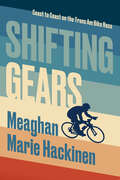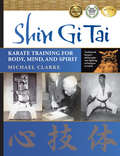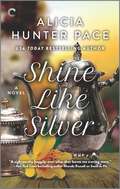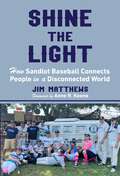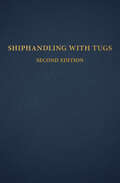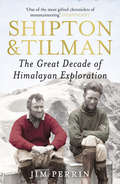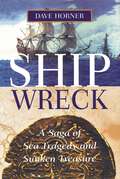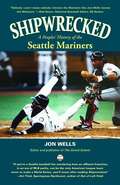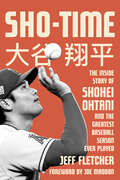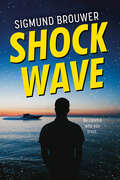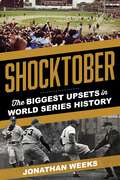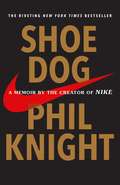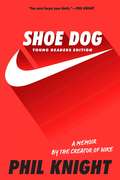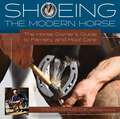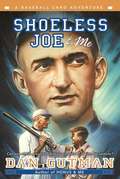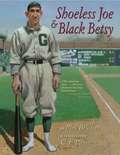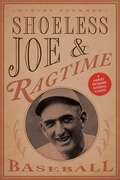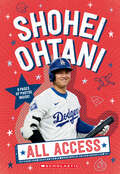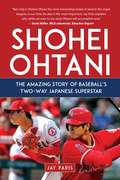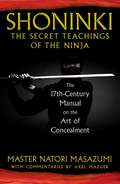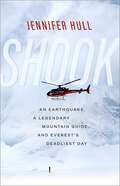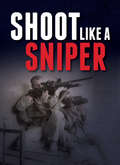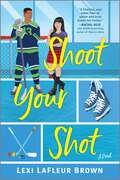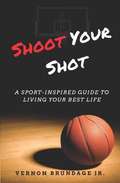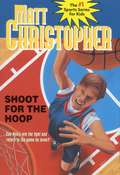- Table View
- List View
Shifting Gears: Coast to Coast on the Trans Am Bike Race
by Meaghan Marie HackinenMeaghan Marie Hackinen’s follow-up to her award-nominated debut South Away charts her unforgettable, twenty-five-day journey on the Trans Am Bike Race: a coast-to-coast ride across the entire North American continent from Oregon to Virginia. Without the aid of a support crew, Hackinen must rely entirely on her wits, ingenuity and sheer determination to finish this extremely challenging feat. A sports story with a unique theme, Hackinen writes about the Trans Am Bike Race as a cultural whole, as she encounters consequences and unforeseen repercussions of an underground, unregulated athletic endeavour. Shifting Gears is another expertly-delivered travelogue and a thrilling glimpse into a world of athletes driven to impossible lengths.
Shin Gi Tai: Karate Training for Body, Mind, and Spirit
by Michael ClarkePrepare to have your beliefs challenged about what karate really is. Within these pages, you will discover traditional karate; along the way, perhaps many of your own beliefs about karate will be confronted. You might have a body capable of mastering karate's physical techniques, but do you have a mind with a level of awareness that is able to grasp the true spirit of karate? For adults only. Regardless of how many people you can defeat in combat, the deeper aim of karate has always been to conquer your own ego, and by doing so, to increase the likelihood of avoiding conflict. When you can control your ego, you have a chance to establish peace in your life--this is the tradition of budo karate. Shin Gi Tai has a literal translation: mind-technique-body. A karate-ka's mind (shin) must be developed ahead of his technique (gi) if he is to discover a sense of balance within his body (tai). While the mental and physical aspects of karate are daunting and cause many to stop training, if you can just endure the early years--say, the first decade--then there is opportunity for real and lasting benefits. Budo is a concept more often discussed than put into practice. Yet, as part of traditional karate training, it has the capacity to dramatically change lives for the better, but only if you are prepared to move past the obvious and strive to understand the philosophy and the morality of budo. Your life is yours, your karate is yours; accept ownership of both and reap countless rewards.
Shine Like Silver: A Small Town Southern Romance (Good Southern Women #3)
by Alicia Hunter PaceYou can map out your future, but sometimes the heart has other plans… Don&’t miss this enchanting next installment in USA TODAY bestselling author Alicia Hunter Pace&’s Good Southern Women series. Ava Grace Fairchild never expected to find herself on the back of a hockey player&’s motorcycle. Until now, her life in Laurel Springs, Alabama, has been everything you&’d expect for a Southern belle: old money, silver spoons and a perfectly planned future. But you can&’t plan for the kind of public humiliation that has her running away from her well-ordered life to spend one perfect night with a stranger. Russian enforcer Luka Zadorov is no fan of the South. Being traded to Alabama has meant swapping the glory of northern hockey for playing second fiddle to college football, but his plan to get traded back hits an interesting snag when he crosses paths with Ava Grace. Maybe the South has something to offer after all… Together, Luka and Ava Grace are finally enjoying the present instead of worrying about the future. But when their no-strings fling suddenly develops the kind of strings you can&’t ignore, it&’s time for them both to confront what their hearts truly need.Good Southern WomenBook 1: Sweet as PieBook 2: Smooth as SilkBook 3: Shine Like Silver
Shine the Light: How Sandlot Baseball Connects People in a Disconnected World
by Jim MatthewsThe sandlot movement is a different animal, drawing players of all ages back to their roots. If you remember playing baseball in yards and alleyways or an open field, you&’ll be glad to know the tradition continues in grownup leagues across the nation. A lifelong fan of baseball—both from a watching and a semi-pro player—author Jim Matthews spent his professional days as a television newscaster and sports broadcaster in Austin, Texas. After what he thought would be his last semi-pro game, ending with a home run, he pondered what could fill the void of playing the game he loved. Pondering this conundrum, Matthews and lifelong friend (and former Nike president) Elliott Hill decided that going back to their roots—sandlot baseball—might be just what they needed. Testing the waters with a few different teams and leagues, including future rivals the Texas Playboys, they decided to create their own team: the Austin Moontowers. But when it comes to playing on the sandlot, as it was as a child, the key was not if you won or lost. Camaraderie, not rivalry, spurs you.Shine the Light includes glimmers of friendships resurrected half a century later and new friendships with interesting and sometimes high-profile players, now part of the &“sandlot nation.&” It shares a personal backstory about my dual heritage (Hispanic and Scot-Irish), the parents who shaped Jim&’s character, and tragedies mixed with soaring milestones. Most of all, this is a book about cross-country adventures that landed Matthews back home to Austin, and onto sandlots despite arthritic knees and a hip replacement. It&’s about passion and esprit de corps that can only be found on base or in front of the pitching mound—on a field that may be full of weeds or fire ants. But when you&’re able to play the game you love, in its purest form, the small things that might bother most just come with the territory. Find the Moontowers Baseball Club at instagram @austinmoontowers and www.moontowers.co.
Shiphandling with Tugs
by Jeffrey SleisingerShiphandling with Tugs, Second Edition is the most comprehensive text available for the mariner who wants to learn how to safely and effectively operate tugs in assisting ships to and from their berths in ports and anchorages. Captain Jeffrey Slesinger used his extensive knowledge of the industry to bring Reid’s original edition, published in 1986, up to date with current technologies and standards, adding sections on the advances made in tug design, and line and winch technology. Shiphandling with Tugs, Second Edition includes a new chapter on ship escort with updated and expanded chapters on today’s tugs, including descriptions and illustrations of the latest tractor tug designs and capabilities.
Shipton and Tilman
by Jim PerrinUsing unpublished diaries, Jim Perrin, the acclaimed author of The Villain and Menlove, tells the story of the greatest exploring partnership in British history. In the 1930s Tilman and the younger Shipton pioneered many routes in Africa and the Himalayas and found the key to unlocking Everest. They crossed Africa by bicycle, explored China with Spender and Auden, journeyed down the Oxus River to its source and, with no support, opened up much of the Nepalese Himalaya. In the words of Jim Perrin, 'The journeys of discovery undertaken through two decades by this pair of venturesome ragamuffins are unparallelled in the annals of mountain exploration.' Jim Perrin writes of his source-material: 'These unpublished diaries, journals, and extensive correspondence have not previously been used to present a portrait of the most productive friendship in the history of mountain exploration. What they reveal is, in Shipton's phrase, "a random harvest of delight" gathered by two uniquely bold and engaging characters from the great mountain ranges of the world during the golden era of their first western exploration. Between geographical excitement, the nature of arduous travel in difficult and uncharted terrain throughout a lost epoch, and the quirkiest and most stimulating of friendships, the theme is a gift, and one that has long been waiting for adequate treatment'.
Shipwreck: A Saga of Sea Tragedy and Sunken Treasure
by Dave HornerBased on the exceptional and fascinating eyewitness account of a seventeenth-century Spanish padre, Dave Horner's Shipwreck is the absorbing and true story of two immense galleons that were lost (along with hundreds of passengers and millions of pesos in treasure) to disasters at sea. Shipwreck is an extraordinary literary adventure which interweaves accounts of the many attempts throughout the past three centuries to recover the sunken treasure, including the recent discovery and salvage of one of the galleons by Dave Horner himself. Shipwreck is an outstanding history of true adventure on the high seas, past and present, which is wonderfully enhanced for the reader with 50 photographic illustrations, six maps, four line drawings, seven appendices, as well as bibliographies of archival sources, institutions, original documents or primary works, and a general listing of thematically appropriate titles for further suggested readings.
Shipwrecked: A Peoples' History Of The Seattle Mariners
by Jon WellsJon Wells, a baseball writer who has covered the Seattle Mariners for more than 15 years, asserts that poor management and shortsighted ownership combined to keep a team with three first-ballot Hall of Fame players, each in the prime of his career, from reaching the World Series. Wells details every misstep by the Mariners during the team's 35-year history. But wait, there's hope! Can General Manager Jack Zduriencik bring in enough young talent to make this club a contender again, as he did for the Milwaukee Brewers?
Sho-Time: The Inside Story of Shohei Ohtani and the Greatest Baseball Season Ever Played
by Jeff FletcherThe story behind Major League Baseball’s two-way playing phenomenon and his rise from early days in Japan to his historic 2021 MVP season.Shohei Ohtani of the Los Angeles Angels is playing baseball like no other major leaguer since Babe Ruth. His dominance as a two-way player—an electric pitcher and an elite slugger—made him the 2021 American League Most Valuable Player, the only player ever selected as an All Star as both a pitcher and hitter, and a member of Time 100’s most influential people of 2021.In Ohtani’s first two-way game of the 2021 season, he threw a pitch at 100 mph and hit a homer that left his bat at 115 mph, a confluence of feats unmatched by anyone else in the sport. He racked up eye-popping achievements all year. But awards and numbers tell only part of his amazing story.In Sho-Time, award-winning sportswriter Jeff Fletcher, who has covered Ohtani more than any other American journalist, charts Ohtani’s path through Japanese baseball to a championship with the Nippon-Ham Fighters, the recruiting war to bring him to the majors, his 2018 AL Rookie of the Year campaign, subsequent injury-riddled seasons, and then his historic 2021 season. Along the way, Fletcher weaves in the history of two-way players—including Babe Ruth and unsung Negro Leagues players like “Bullet” Joe Rogan, Martín Dihigo, and Ted “Double Duty” Radcliffe—and the Japanese athletes who preceded Ohtani in the majors. With insight from Japanese and American baseball front office personnel, managers, scouts, athletic trainers, ballplayers, and more, Sho-Time breaks down the physics of Ohtani’s game, his technologically advanced training, his international fame, and the role he and teammate Mike Trout are playing to lead baseball into the next generation.Praise for Sho-Time“Jeff Fletcher masterfully chronicles not only what Ohtani accomplished in ‘21, but also provides the full context to his achievements. . . . Fletcher’s book is the definitive look at Ohtani’s two-way majesty.” —Ken Rosenthal, Senior Writer at The Athletic“Historians will be talking about Shohei Ohtani’s 2021 season for decades, and thankfully the baseball gods arranged for Jeff Fletcher to be there to cover baseball’s best two-way player ever in the midst of a pandemic, to bear witness and mine details and write with grace about the sport’s most incredible individual performance.” —Buster Olney, ESPN“The essential portrait of baseball’s most captivating player. . . . Fletcher goes beyond the carefully scripted press conferences, revealing in vivid detail the challenges and triumphs of a baseball journey like no other.” —Tyler Kepner, The New York Times
Shock Wave (Orca Soundings)
by Sigmund BrouwerIt’s the first week of summer and former army brat Jake Ballard is spending it alone at his uncle’s cottage while his mom gets treatment for PTSD. Jake's boring day gets flipped upside down when a beautiful stranger asks him to help play a prank on her friends. But when an angry crime boss turns up at the cottage the next morning, Jake is sure of two things: the night before was a big mistake, and that girl was no prankster. And she is nowhere to be found. Jake has twenty-four hours to return the stolen goods...or else. He has no other choice but to find the girl—and hopefully not find himself in any more trouble than he’s already in.
Shocktober: The Biggest Upsets in World Series History
by Jonathan WeeksBaseball&’s October showcase has provided some high drama over the years. Willie Mays&’s spectacular catch in 1954, Bill Mazeroski&’s walk-off homer in 1960, and Kirk Gibson&’s pinch-hit blast in 1988 are just a few of the memorable moments that have dominated highlight reels. The outcome of the Series has not always been terribly surprising—especially during the late 1940s and early 1950s when the Yankees captured five consecutive championships, breaking their previous record of four straight titles from 1936 to 1939. But in spite of its predictability at times, the Fall Classic has taken many unexpected turns. The 1906 Cubs lost to the weak-hitting White Sox after establishing a new regular season record for wins. The 1955 Dodgers avenged seven prior October failures with an improbable victory over the seemingly invincible Yankees. And in 1969, the Mets finally shed their image as &“loveable losers,&” dethroning the powerful Orioles. In more than a century of World Series plays, a number of similar scenarios have emerged. Twenty-two of those stories are told in Shocktober. The book also includes an appendix of game statistics as well as a section on World Series trivia.
Shoe Dog: A Memoir by the Creator of Nike
by Phil KnightIn this instant and tenacious New York Times bestseller, Nike founder and board chairman Phil Knight &“offers a rare and revealing look at the notoriously media-shy man behind the swoosh&” (Booklist, starred review), illuminating his company&’s early days as an intrepid start-up and its evolution into one of the world&’s most iconic, game-changing, and profitable brands.Bill Gates named Shoe Dog one of his five favorite books of the year and called it &“an amazing tale, a refreshingly honest reminder of what the path to business success really looks like. It&’s a messy, perilous, and chaotic journey, riddled with mistakes, endless struggles, and sacrifice. Phil Knight opens up in ways few CEOs are willing to do.&” Fresh out of business school, Phil Knight borrowed fifty dollars from his father and launched a company with one simple mission: import high-quality, low-cost running shoes from Japan. Selling the shoes from the trunk of his car in 1963, Knight grossed eight thousand dollars that first year. Today, Nike&’s annual sales top $30 billion. In this age of start-ups, Knight&’s Nike is the gold standard, and its swoosh is one of the few icons instantly recognized in every corner of the world. But Knight, the man behind the swoosh, has always been a mystery. In Shoe Dog, he tells his story at last. At twenty-four, Knight decides that rather than work for a big corporation, he will create something all his own, new, dynamic, different. He details the many risks he encountered, the crushing setbacks, the ruthless competitors and hostile bankers—as well as his many thrilling triumphs. Above all, he recalls the relationships that formed the heart and soul of Nike, with his former track coach, the irascible and charismatic Bill Bowerman, and with his first employees, a ragtag group of misfits and savants who quickly became a band of swoosh-crazed brothers. Together, harnessing the electrifying power of a bold vision and a shared belief in the transformative power of sports, they created a brand—and a culture—that changed everything.
Shoe Dog: Young Readers Edition
by Phil KnightIn this young readers edition of the New York Times bestseller, Nike founder and board chairman Phil Knight “offers a rare and revealing look at the notoriously media-shy man behind the swoosh” (Booklist, starred review), opening up about how he went from being a track star at an Oregon high school to the founder of a brand and company that changed everything.You must forget your limits. It was only when Nike founder Phil Knight got cut from the baseball team as a high school freshman that his mother suggested he try out for track instead. Knight made the track team and he found he could run fast and even more he liked it. Ten years later, young and searching, Knight borrowed fifty dollars from his father and launched a company with one simple mission: import high quality running shoes from Japan. Selling the shoes from the trunk of his car to start, he and his gang of friends and runners built one of the most successful brands ever. Phil Knight encountered risks and setbacks along the way, but always followed his own advice. Just keep going. Don’t stop. Whatever comes up, don’t stop. Filled with wisdom, humanity, humor, and heart, the young readers edition of the bestselling Shoe Dog is a story of determination that inspires all who read it. The Young Reader’s Edition is an abridged version of the internationally bestselling adult book and it features original front matter and back matter, including a new introduction and “A Letter to the Young Reader” containing advice from Phil Knight for budding entrepreneurs.
Shoeing the Modern Horse
by Steven Kraus Katie NavarraThe must-have reference for effective and responsible shoeing for the good of the horse.All horses have four hooves that are integral to their overall health, their athletic ability, and ultimately, their longevity, whether their &“job&” is simply grazing in a pasture or competing at the highest levels. But not all horses are the same
Shoeless Joe & Me
by Dan GutmanWhen Joe Stoshack hears about Shoeless Joe Jackson -- and the gambling scandal that destroyed the star player's career -- he knows what he has to do. If he travels back in time with a 1919 baseball card in his hand, he just might be able to prevent the infamous Black Sox Scandal from ever taking place. And if he could do that, Shoeless Joe Jackson would finally take his rightful place in the Baseball Hall of Fame. But can Stosh prevent that tempting envelope full of money from making its way to Shoeless Joe's hotel room before the big game?
Shoeless Joe And Black Betsy
by Phil BildnerNo one knew better than Shoeless Joe Jackson what was needed to become the best baseball player ever: a good bat. And no one knew more about bats than Ol' Charlie Ferguson of South Carolina, a good friend of Joe's. With love, nurture, and a lot of hard work, the two friends created Black Betsy -- the finest bat in all the land. And with a bat the likes of her by his side, you can bet Joe went all the way to the major leagues!
Shoeless Joe and Ragtime Baseball
by Harvey FrommerAnother peek at baseball's good old days—or, in this case, bad old days—by veteran sports-historian Harvey Frommer. Frommer paints Shoeless Joe as a baseball natural ("Joe Jackson hit the ball harder than any man ever to play baseball"—Ty Cobb), an illiterate hick (his table utensils consisted of knife and fingers), and an innocent man snared by the greatest scandal in baseball history.
Shohei Ohtani: All Access (All Access)
by ScholasticDiscover all the stats and facts about baseball legend Shohei Ohtani in this home-run biography!Get to know baseball player Shohei Ohtani, a legendary "two-way player" who has smashed numerous baseball records! This biography is full of facts, trivia, stats, and so much more! Follow Shohei from his childhood growing up in Japan, all the way to his professional baseball career playing for the LA Dodgers, and learn all about how he became one of the best baseball players in the world!This All Access book is a must read for any baseball fan! Includes eight pages of color photos!
Shohei Ohtani: The Amazing Story of Baseball's Two-Way Japanese Superstar
by Jay ParisRarely does anyone use the term “two-way” in regard to a baseball player. Yet the Los Angeles Angels’ Shohei Ohtani, at the young age of twenty-three, has become the epitome of the term, drawing comparisons to Babe Ruth by baseball pundits everywhere. After being drafted by the Hokkaido Nippon-Ham Fighters of the Japan Pacific League with the number-one pick in 2012, the eighteen-year-old Ohtani struggled with the bat during his rookie season. However, he had a breakout year in 2014, posting a 2.61 ERA in 24 starts and 179 strikeouts (as well as 10 home runs). By 2017, all thirty Major League Baseball teams had heard about the Japanese phenom and expressed interest in signing him. Ultimately, the Angels offered him the opportunity to compete as a two-way player and the chance to accomplish his professional goals. After a quiet spring training, Ohtani broke out in the first two weeks of the 2018 regular season, becoming just the 14th pitcher in major-league history to strike out 12 batters in one of his first two starts. He also homered in three consecutive games during that stretch. Shohei Ohtani: The Amazing Story of Baseball’s Two-Way Japanese Superstar tells the story of the player from rural Japan who became a two-way star not seen in America since Babe Ruth. With highlights of his best games on the mound and at bat from each month of his rookie season and anecdotes of his life in America, this is the one book that every fan will want.
Shoninki: The 17th-Century Manual on the Art of Concealment
by Axel Mazuer Master Natori MasazumiThe classic text on the mystical traditions of the ninja now decoded in English • The path of the ninja as an authentic spiritual discipline • Details the art of concealment and espionage, including methods of disguise, survival techniques, and face reading • A ninja response to the Samurai Bushido and the way to mind-body harmony Experts in disguise, infiltration, espionage, and counterintelligence, the ninja had spiritual values and magical traditions that distinguished them from the soldierlike samurai. Their art of ninjutsu, invisible as well as indispensable, was transmitted in secret schools and relied on only a few books, which were written in code. The Shoninki, one of the most important of these coded manuals, was written in 1681 by Master Ninja Natori Masazumi. Presenting all facets of the art of concealment, espionage, and physical prowess, including methods of disguise and survival techniques, this source text also contains teachings on spiritual meditations, psychic powers, the art of face reading, controlling the emotions, and magic spells. Revealing the connection between the ninja and the yamabushi--warrior monks who were endowed with supernatural powers--this classic text confirms the path of the ninja as an authentic spiritual discipline, one of self-realization and detachment and the way to mind-body harmony.
Shook: An Earthquake, a Legendary Mountain Guide, and Everest's Deadliest Day
by Jennifer HullDave Hahn, a local of Taos, New Mexico, is a legendary figure in mountaineering. Elite members of the climbing community have likened him to the Michael Jordan, Cal Ripken, or Michael Phelps of the climbing world. The 2015 expedition he would lead came just one short year after the notorious Khumbu Icefall avalanche claimed the lives of sixteen Sherpas. Dave and his team—Sherpa sirdar Chhering Dorjee, assistant guide JJ Justman, base-camp manager Mark Tucker, and the eight clients who had trained for the privilege to attempt to summit with Dave Hahn spent weeks honing the techniques that would help keep them alive through the Icefall and the Death Zone. None of this could have prepared them for the earthquake that shook Everest and all of their lives on the morning of April 25, 2015. Shook tells their story of resilience, nerve, and survival on the deadliest day on Everest.
Shoot Like a Sniper
by Gun Digest EditorsThis book is about human performance. The controlling characteristic of this is one's mind. Within the context of rifle shooting, there are definite ways in which our state of mind can either help or hurt us. So, it pays to recognize what to seek and what to avoid. Further, an unfortunate aspect of the human mind (especially the male mind) is the "I don't need to ask for directions/read the instructions/learn from someone else" mindset.Now if you are reading this you probably aren't one of that crew, but it is still sometimes difficult to open our minds to new ideas or to take an honest, critical look at ourselves. However, this willingness to learn and to honestly analyze and critique one's self is an absolute requirement for progress, so try to keep that in mind whenever you start a practice session. Ego is the most self-destructive characteristic we possess; don't take it to a practice session.
Shoot Your Shot: A Hockey Rom-Com
by Lexi LaFleur BrownDon&’t miss NHL insider and #BookTok influencer Lexi LaFleur Brown&’s steamy and superstitious hockey rom-com debut!&“One of the best debut novels I&’ve ever read—I ate this book up! Shoot Your Shot is fun, sexy, and brimming with heartfelt emotion.&” —Lauren Blakely, #1 New York Times bestselling authorJaylen &“JJ&” Jones&’s hockey career is over. After not securing an NHL contract with the Seattle Rainiers, Jaylen decides to bid the city farewell with a final night of fun, blowing off steam with an anonymous one night stand. But when a last-minute roster spot opens up on the Rainiers, he connects his luck to the girl he spent the night with. Superstitious Jaylen is desperate to keep her around—his career depends on it. Aspiring tattoo artist Lucy Ross isn&’t so sure about the proposition to remain Jaylen&’s lucky charm—she&’s been called a lot of things in her life, but good luck has never been one of them. But stuck in a career slump, Lucy has everything to gain. Hoping for an apprenticeship hasn&’t offered much stability, and Jaylen is willing to pay any price to get Lucy to agree…so maybe sending him a routine text message before each game won&’t be too hard. What starts as an agreement to trade favors—a good luck text in exchange for tattooing practice for Lucy&’s portfolio—quickly turns into sizzling chemistry that&’s too delicious to deny. But Lucy&’s been in too many situationships to even think about getting attached again, and Jaylen is clearly only with Lucy as long as it&’s helping his gameplay… Neither of them expecting getting lucky could be so complicated."A hilarious, sexy debut from an author who truly knows her hockey." —Rachel Reid, USA TODAY bestselling author of Time to ShineFOR FANS OF: Bisexual rep Grumpy x Sunshine Golden Retriever hero, Black Cat heroine He Falls First Relationship of convenience Forced proximity
Shoot Your Shot: A Sport-inspired Guide To Living Your Best Life
by Vernon BrundageMichael Jordan. Kobe Bryant. LeBron James. Stephen Curry. Kawhi Leonard. Giannis Antetokounmpo. James Harden. Kevin Durant. Russell Westbrook. These are some of the most high profile names in one of the world's most popular sports--basketball. But what steps did they take to elevate themselves to superstardom? What principles did they follow in order to become the best of the best? More importantly, how can you use their example to attain success in all of your endeavors? 'Shoot Your Shot' identifies the key principles that the world's most elite basketball players have applied to their lives and explains in detail how you can can use those same exact principles to help you navigate through life, accomplish your goals, and realize your dreams. Divided into Quarters and making you feel like you are in an actual basketball game, 'Shoot Your Shot' provides an entertaining and unique reading experience while equipping you with proven tools for success. More than just a book about sports, 'Shoot Your Shoot' is suitable for everyone--regardless of age, gender, background, or standing in life. « Less
Shoot for the Hoop
by Matt ChristopherForced to referee rather than play basketball after he has been diagnosed as being diabetic, Rusty believes he will never play again until a new man in town organizes a team and coaches him.
